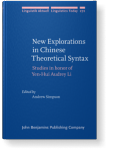Miao-Ling Hsieh
List of John Benjamins publications for which Miao-Ling Hsieh plays a role.
Journal
2022 On the mirative marker leh 4 in Taiwanese Southern Min New Explorations in Chinese Theoretical Syntax: Studies in honor of Yen-Hui Audrey Li, Simpson, Andrew (ed.), pp. 445–478 | Chapter
This paper shows that the sentence final leh4 咧 with an actual pronunciation of a low third tone can independently mark mirativity from either the speaker’s or the addressee’s perspective. The range of mirative meanings that the mirative leh4 咧 expresses include (a) sudden discovery, sudden… read more
2022 On the “one+verbal classifier” sequence as a delimitative aspect marker in Taiwanese Southern Min Language and Linguistics 23:4, pp. 680–709 | Article
This paper studies the “one+verbal classifier” sequence tsi̍t-ē that appears after an indefinite object complement in Taiwanese Southern Min. We call it the post-complement (PC) tsi̍t-ē. While the tsi̍t-ē sequence can be a durative phrase when it is immediately preceded by a verb, the PC tsi̍t-ē… read more
2020 台灣閩南語分類詞之檢驗 [Distinguishing classifiers in Taiwanese Southern Min] Language and Linguistics 21:3, pp. 375–407 | Article
近年來台灣閩南語(以下簡稱台語)的研究逐漸受到重視,量詞相關的研究不少,然而專門針對台語分類詞的研究相對稀少,主要的原因可能在於分類詞的定義不清,導致各家看法不一,甚或略而不談,連帶影響分類詞的教學。本文以Her & Hsieh (2010)和Her (2012)對於漢語分類詞與量詞所提出語意和語法測試作為基礎,界定台語分類詞範疇,並重新檢驗歷年文獻所提出的台語分類詞或量詞語料,建立83 個分類詞清單,其中65 個為分類詞,18 個為分類詞與量詞兼具,此清單可以與台灣華語的分類詞清單做比較(如:Her & Lai (2012)),作為台語分類詞研究與教學之參考。
read more2020 Acquiring the polysemous adverb HAI in Chinese by English-speaking, Japanese-speaking, and Korean-speaking CSL learners Concentric 46:2, pp. 173–205 | Article
Using corpus analysis and error analysis, this study investigates English-speaking, Japanese-speaking, and Korean-speaking Chinese learners’ acquisition of various meanings of hai in Mandarin Chinese, including its temporal meaning ‘still, yet’ as well as its abundant atemporal meanings involving… read more




